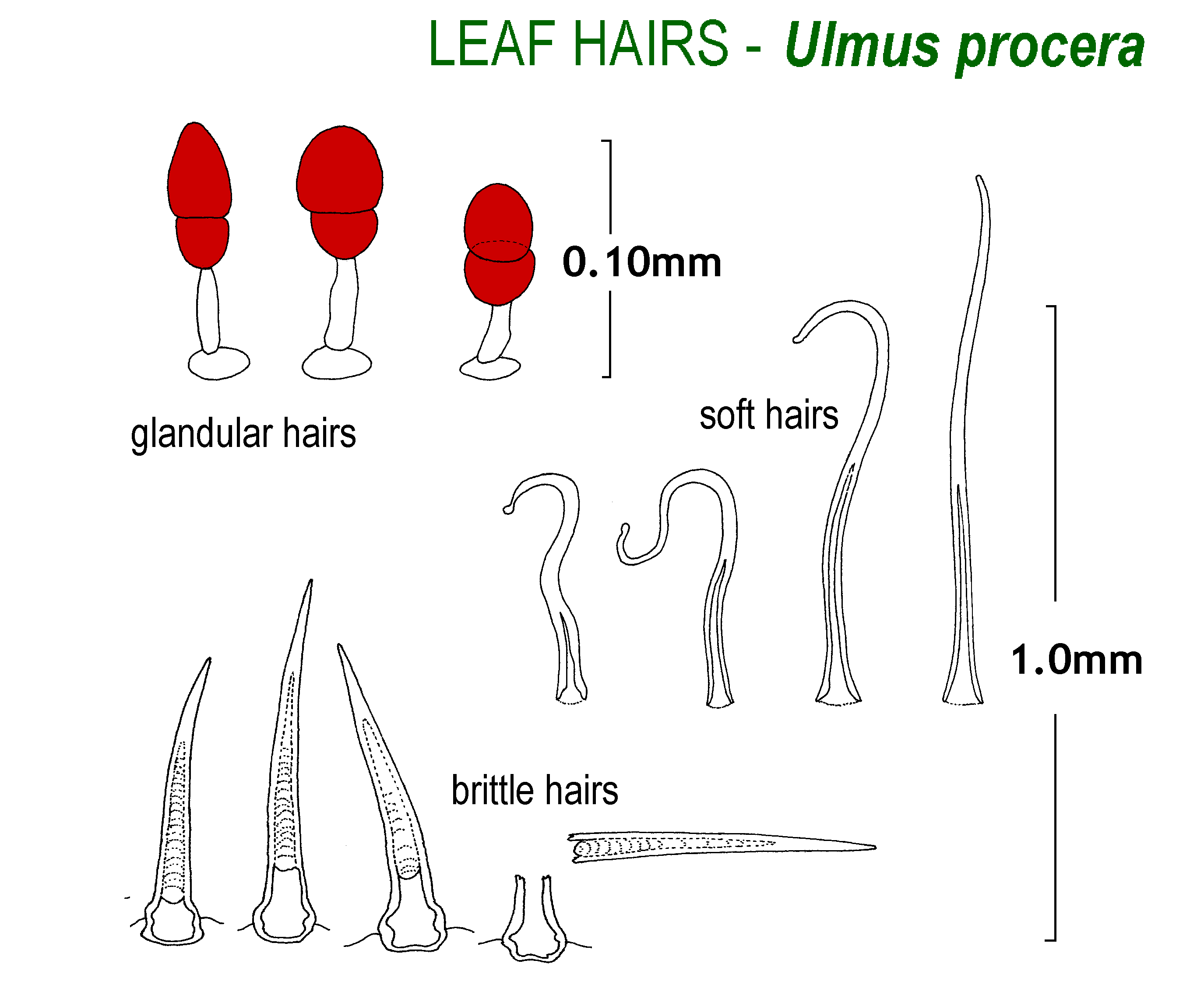ESSEX BOTANY AND MYCOLOGY GROUPS
|
|
|
|
|
|
|
|
|
|
|
ESSEX BOTANY AND MYCOLOGY GROUPS |
|||||||||
|

|
How different then is Ulmus procera from the U. minor series of elms? Is it likely to be just one node in a continuous range of variation? One character that separates it from the smooth-leaved group of minor elms is the scabrid upper surface to the leaf. When rubbing one's finger across the upper surface of the leaf it feels like fine glasspaper. The underside of the leaf is usually, however, soft to the touch. Examination of the indumentum under the microscope reveals that on the upper surface a fairly dense array of stiff needle-pointed hairs occurs on the lamina surface. These are up to 0.5mm long and have a hollow swollen basal bulb. The rest of the hair however is filled by a solid matrix that appears to have been laid down in hemispherical layers down from the apex. These hairs are rigid and very sharp. When a finger is brushed over them, they either snap off at the junction of the hair and the hollow basal bulb, leaving a stiff jagged spike that en mass we detect with our fingers as a rough surface - or they impale one of our dead skin cells (as can be seen under the microscope). On the lower surface rather similar hairs occur, but they are longer (to 1mm), usually curly in shape, are flexible, feel soft to the touch and do not break off when stroked. They are hollow and do not seem to be filled with the solid matrix that distinguishes the hairs on the upper surface. Moreover they appear white in colour, presumably due to the refractile nature of the cavity, whereas the brittle hairs are glass-like and transparent. I suspect that the soft hairs are simply composed of hollow dead cells with cellulose walls, whereas the brittle cells are somehow impregnated with silica. In the minor elms the soft curly hairs occur on the underside of the leaves as axillary tufts at the junction of the main veins and the midrib and are up to 1.0mm long, and there are no brittle spiny hairs on either surface. In U. procera the soft hairs tend to occur along the surface of the veins as well as in axillary tufts, and are also scattered across the lower lamina. Brittle spiny hairs also occur on the underside along the main veins, however, intermixed with soft hairs. In his paper on the Elm complex in Britain, Max Coleman (2002) mentions that the Ulmus minor elms, and their hybrids, bear minute red glands on the underside of the leaves, and that these are absent in U. glabra. He does not however mention whether or not they occur on the English Elm U. procera. Well they do, and in vast numbers. Although minute (40-60 μm in length) they can be observed in a good light in the field with a x20 lens, when they appear a deep ruby red. Under the microscope, they appear pale red in reflected and orange in (tungsten) transmitted light. These glands consist of a basal cell, a stalk cell, both transparent, and a pair of spherical to ovoid gland-apex cells with deep ruby red contents, all in a line.The ruby-tipped glandular hairs, are minute by comparison, hardly 1/10th the size of the other hairs. In young leaves of both the minor and procera elms they occur in thousands along all the veins, including the ultimate venules. They are most readily seen by holding a leaf up to the sky under a x20 lens and looking for the almost transparent final venules, against which they will be illuminated by the light transmitted through the leaf. In both taxa they also occur along the main veins on the upper surface of some of the leaves. The ruby glands also occur, though usually at a much lower density, on the leaves of the various U. minor x glabra hybrid clones. What can they be for? The lower leaf surfaces have numerous strange carrot shaped mites all over them, of about the same size as the glands. Can they be some sort of defence against these? They seem to burst rather readily and distribute their red contents as a splodge on the lamina surface. As for the spiny hairs, why are they produced by the Atinian/English Elm? Columella tells us that cattle prefer the taste of the leaves to those of other elms. Could they have evolved as some sort of defence against browsing of the palatable mature leaves? Maybe they are not so vicious or plentiful on the juvenile leaves that would develop after lopping. Reference: Coleman, M. (2002) British Wildlife 13. 390.
|